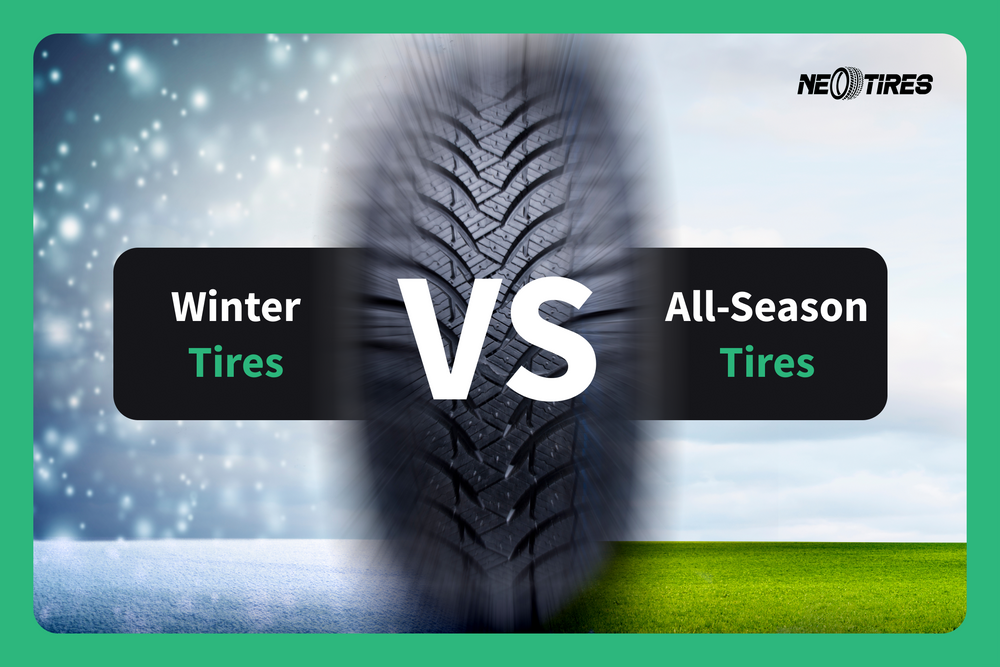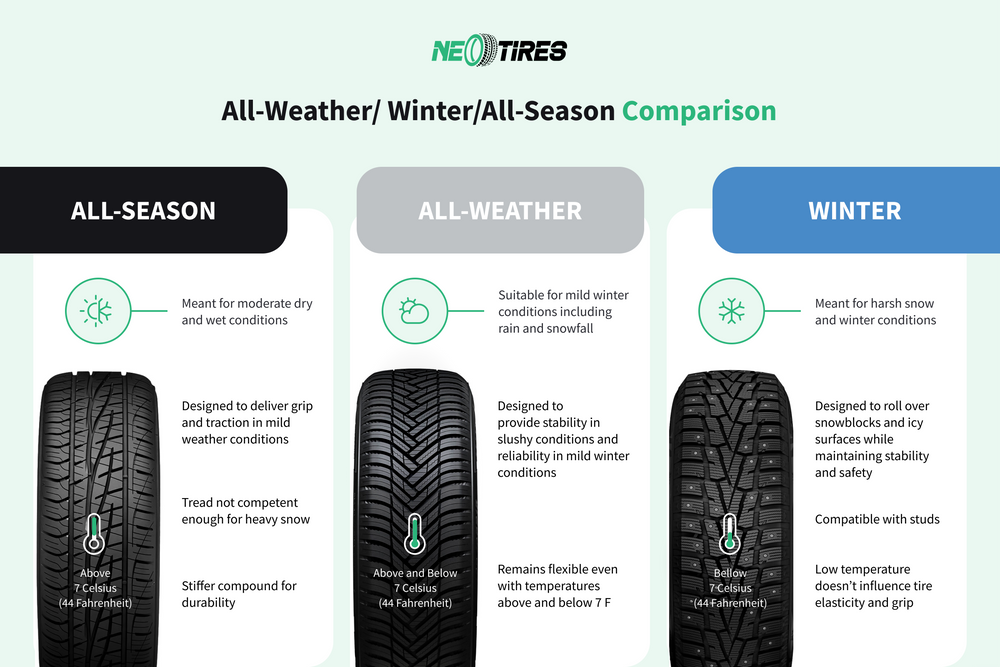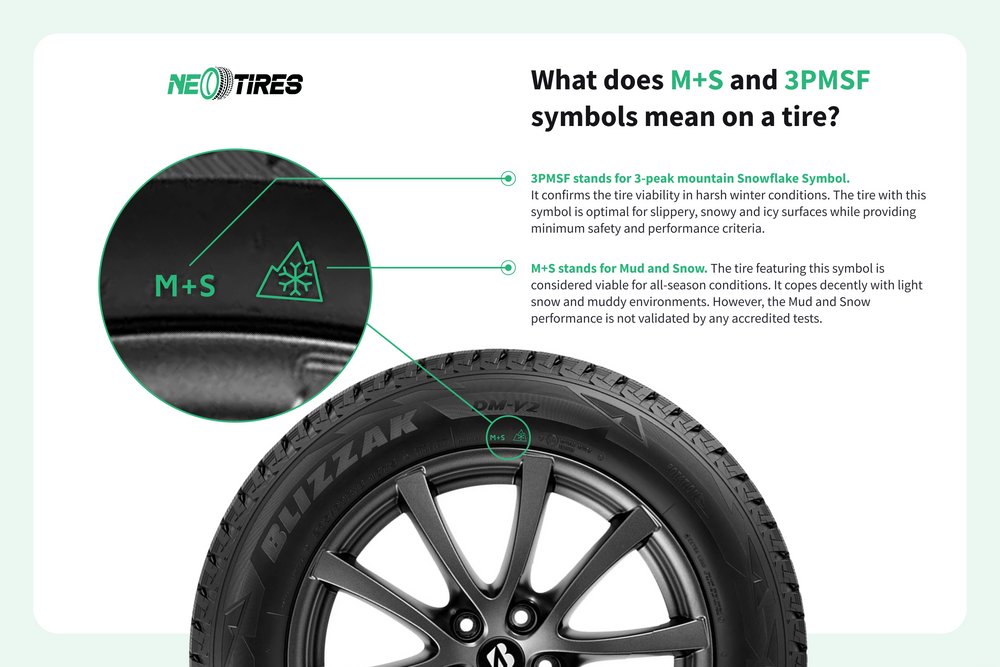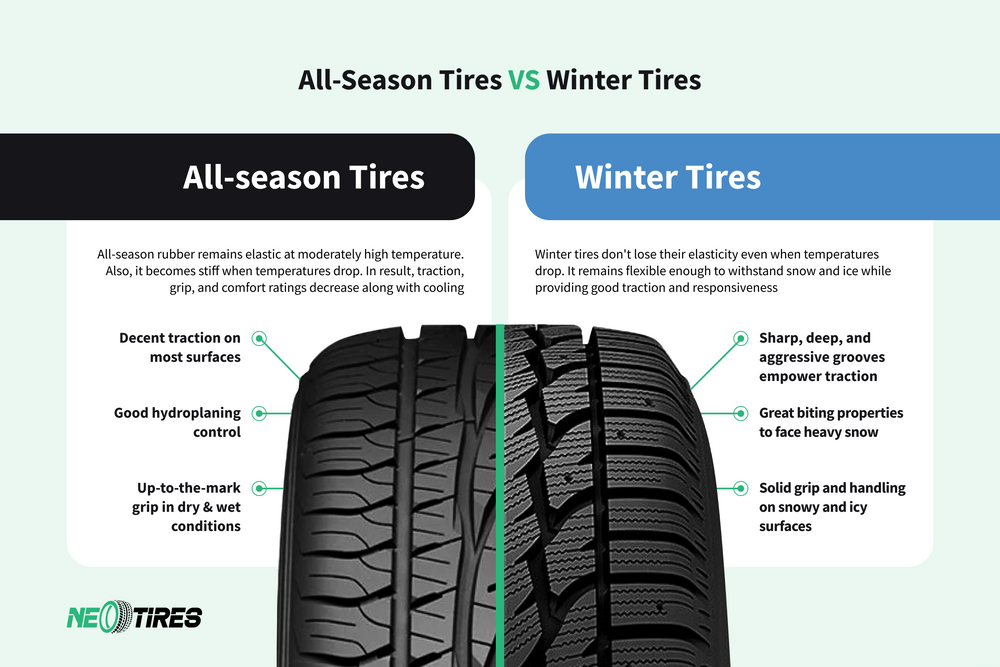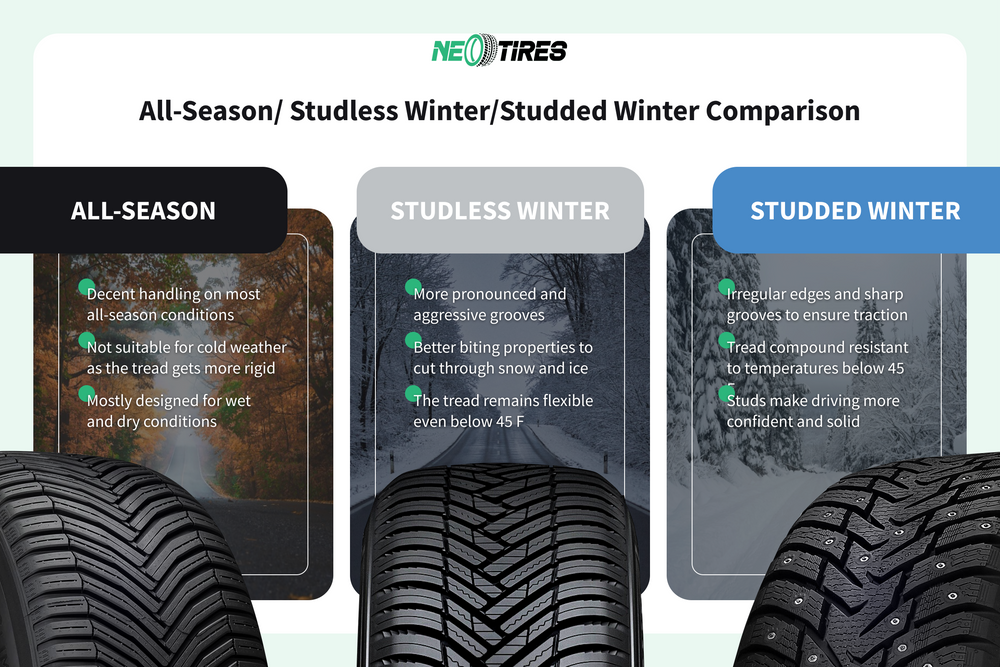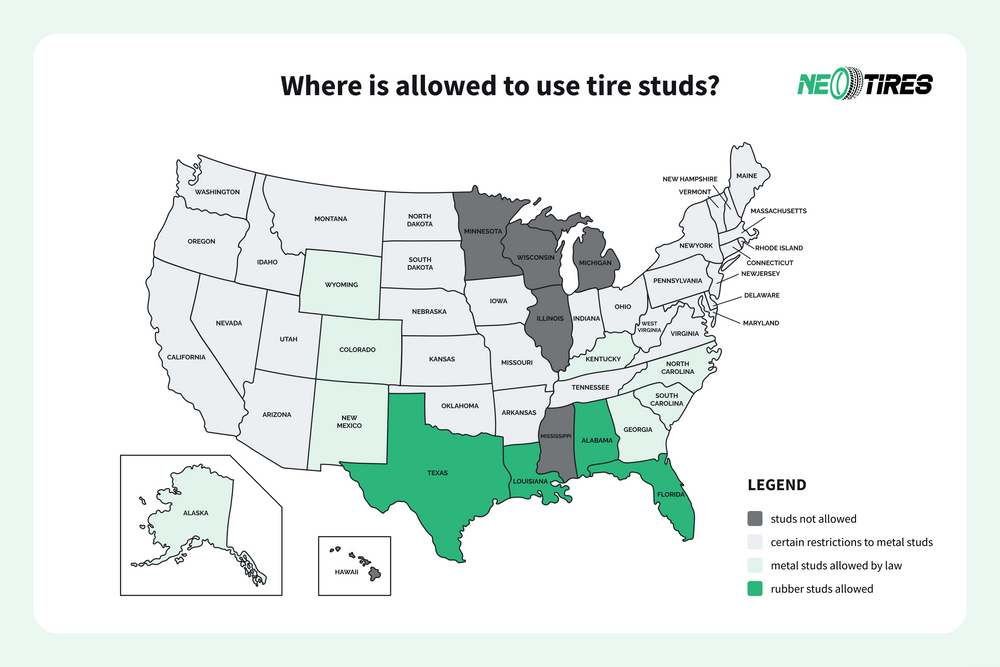Every driver knows that there are different types of tires. Each type, be it all-season, winter, summer, or all-weather has its purpose well-defined by the manufacturers. They differ in the depth of the tread as well as in their architecture. One of the most frequent questions is whether winter tires can replace all-season ones and vice versa.
In this article, we will explain step by step what is the difference between these 2 types and how interchangeable they can be between them. Once you understand the difference better, you will be able to make the correct choice of the right set of tires for your needs. After all, the correct choice of tire ensures your safety on the road - which is the most important aspect.
What Makes All-Season and Winter Tires Different?
If you carefully observe the structure of an all-season tire and a winter tire, you will notice that their architecture differs greatly. One has the goal of providing a comfortable, smooth, and quiet ride. Another is intended to provide more power in extreme weather conditions, such as winter. So, you guessed correctly: the first tire is the all-season one, which is optimal for year-round traction and enough power to combat light snow. However, this is not ready to face the deep snow and thick ice.
The one that is capable of facing harsh conditions is exclusively the winter tire. It perfectly copes with low temperatures, remaining flexible and able to overcome the toughest road conditions. Its architecture has multiple biting edges, grooved treads, and deep groves to effectively bite blocks of snow and ice. Some drivers opt for studdable winter tires that improve traction even more. Here you have an explanatory image of the specifics of all-season tires vs. winter, as well as their indicative resistance at different temperatures.
Specific Markings Found On All-Season And Winter Tires
Winter and all-season tires usually have certain markings. They inform drivers how viable they are for certain conditions. Most all-season tires will have the "M+S" marking on their sidewall. This marking is deciphered as "Mud+ Snow". While many drivers confuse them with specialized winter tires, this marking has a different meaning.
The "Snow" in the inscription suggests that the tire withstands moderate winter temperatures. Their structure remains relatively flexible as long as the winter conditions are not extreme. In other words, the "M+S" symbol means that the tire is more resistant to cold than a summer tire, for example. However, it is not sufficiently resistant to harsh winter conditions.
On the other hand, a winter tire has the Three-Peak Mountain Snow Flake symbol. As you can see in the 1st explanatory image, this tire has a much more complex structure. In addition, it has multiple lamellae that act like cutting edges. They form drainage channels for snow and ice, making traction more efficient in complex winter conditions.
It is not excluded to meet tires that have both symbols on their sidewalls. This speaks of the fact that they perform wonderfully in harsh winter conditions. At the same time, you can use it without any problem even in milder winter conditions. The thing is that the "M+S" marking is not so much about the season as about the road condition on which the tire is rolling.
Tread Particularities of Winter vs. All-Season Tires
Engineers draw increased attention to the architecture of winter and all-season tires. Each type of tire must face certain weather conditions. For this, tire makers use different technologies, architectures, and components.
Tread Compounds
To begin with, the tread rubber of the 2 tires differs enormously. Taking into account the extreme temperatures of winter, the tires must withstand cold without becoming stiff. For this, tire makers add special components that keep them elastic even at the lowest temperatures. With sufficient elasticity and pliability, the tire provides great traction and enough power to withstand large and heavy amounts of snow. On the other hand, the all-season tire has a specialized rubber that ensures elasticity both at moderate temperatures (not extreme) and at temperatures slightly above zero. Whenever we use tires that are not suitable for the season, the components in them do not last as they should, making our rides more difficult.
Tread Patterns and Depth
The winter tire will necessarily have a more aggressive and deeper tread. These are the key elements that make it maintain good traction in harsh snow. The all-season tire will also have channels and grooves. But these will be somewhat less aggressive and less deep.
Biting Edges
To improve traction and grip during winter, manufacturers add plenty of biting edges to winter tires. In addition, they feature hundreds of sipes to increase road grip. These are missing in all-season tires because their purpose is different.
A good example of a winter tire is the Bridgestone Blizzak model. It has a multi-cell compound that does not allow snow and slush to reside on the tire tread. Together with the dense siping technology, this tire ensures confident and stable driving in hard snow and ice conditions.
All-Season VS Studless/Studded Winter Tires
Studless and studded tires are part of the same category: both are optimal winter tires. While all-season ones mainly serve mild winter conditions, studded and studless are exclusively meant to endure severe winter conditions.
The difference between studded and studless tires consists of the addition of small elements integrated into the tire to increase traction. As a rule, studded tires are used by drivers who face difficult winters in which heavy snow is always present. Another category is studdable tires, which also refer to winter tires. In their case, drivers add or remove the studs depending on how difficult the winter conditions are.
Studded or Studless?
When choosing between studded or studless tires, you must take into account the laws of the state where you live. Some states prohibit the use of tire studs by law. Others regulate their use according to specific weather conditions. Certain states impose calendar restrictions that allow drivers to use studs in certain months of the year. The last category includes the states that allow the use of rubber studs, which are much friendlier to the road surface than the metal ones.
Your job as a responsible driver is to take into account the laws of the area where you live and use studded tires with caution.
Winter vs All-Season tires: FAQs
Are Winter Tires Better Than All Season Tires?
It depends on the weather conditions. Basically, all-season tires will not perform as well in harsh winter conditions as snow tires. If you live in areas with a lot of snow and ice, then winter tires are definitely better than AS ones. But if the weather conditions are mild, the snow is occasional, and light, all-season ones are a decent option. AS tires resist superbly to temperature changes from mild warm to mild cold and vice versa. Winter tires, however, reduce performance and become fuel-inefficient if they are used in warm weather conditions. Their rubber gets too soft. To benefit from the advantages of winter and all-season tires, you must equip yourself according to the weather conditions.
Can I Use All Season Tires in Winter?
Winters differ depending on the geographical area. If the winter in the area where you live is difficult, with a lot of packed snow and ice layers, all-season tires will not help you much. Winter-dedicated tires are a more reasonable choice. But if the temperatures are around 45º F or 7º Celsius, all-season tires are a good idea. All-season tires are not designed to deal with deep and packed snow. They do well mainly in wet and dry conditions at cool temperatures. All-season tires also do well with light and occasional snow, but not more than that.
What is The Disadvantage of All-Season Tires?
All-season tires are not at all reliable for difficult winter conditions. They tend to slide and lose traction because they do not have a deep enough tread to cope with snowy roads. As such, you can't expect winter versatility with all-season tires, even if their name suggests this.
Why Trust Us?
Our team is dedicated to the deep study of tires and their performance in various conditions. We run our own tests and validate them with top-notch tire professionals we collaborate with. In addition, our team includes mechanics with over 20 years of experience, testers who previously worked for tire production and distribution companies, as well as content writers who ensure the veracity of every piece of information presented in our blog.
Thus, we don't just aim to sell tires; this is a secondary goal for us. The main goal is to provide reliable and trustworthy information for drivers to improve their driving experience. Our trained customer support assistants know a thing or two about all that tires mean and can give you all the necessary assistance at a professional level. So, you can rely on us not only to find the best tire deals but also to receive correct and validated recommendations about tire maintenance and safety tips on the road.
Bottom Line
Try to understand which type of tires suits you better. You can see our best winter tires if you need a strong ally for hard winters. If the conditions in which you drive are predominantly moderate to mild, then a set of all-season options would suit you better. Choose wisely and if you need help, Neotires is here to offer it to you. Drive safe!




